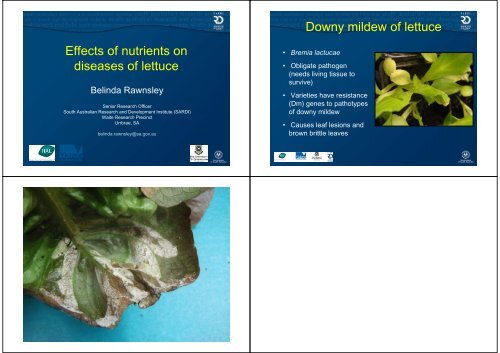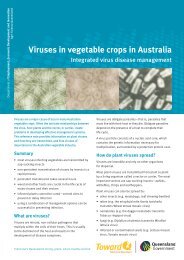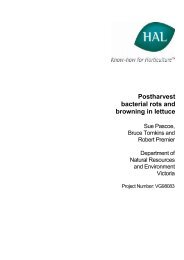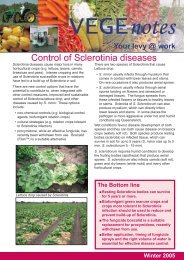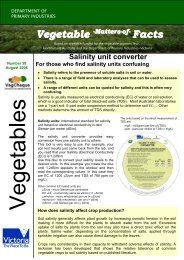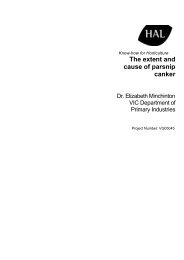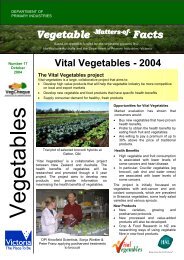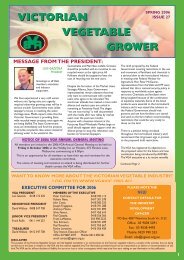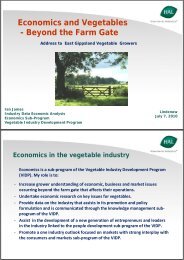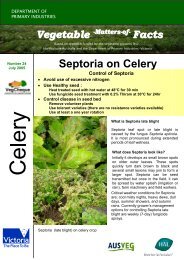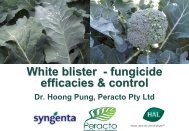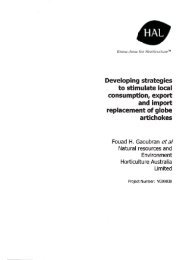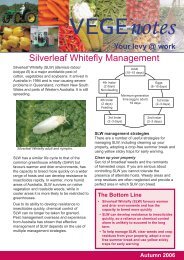Effects of nutrients on diseases of lettuce Downy mildew of lettuce
Effects of nutrients on diseases of lettuce Downy mildew of lettuce
Effects of nutrients on diseases of lettuce Downy mildew of lettuce
You also want an ePaper? Increase the reach of your titles
YUMPU automatically turns print PDFs into web optimized ePapers that Google loves.
<strong>Downy</strong> <strong>mildew</strong> <str<strong>on</strong>g>of</str<strong>on</strong>g> <strong>lettuce</strong><br />
<str<strong>on</strong>g>Effects</str<strong>on</strong>g> <str<strong>on</strong>g>of</str<strong>on</strong>g> <str<strong>on</strong>g>nutrients</str<strong>on</strong>g> <strong>on</strong><br />
<strong>diseases</strong> <str<strong>on</strong>g>of</str<strong>on</strong>g> <strong>lettuce</strong><br />
Belinda Rawnsley<br />
Senior Research Officer<br />
South Australian Research and Development Institute (SARDI)<br />
Waite Research Precinct<br />
Urrbrae, SA<br />
belinda.rawnsley@sa.gov.au<br />
• Bremia lactucae<br />
• Obligate pathogen<br />
(needs living tissue to<br />
survive)<br />
• Varieties have resistance<br />
(Dm) genes to pathotypes<br />
<str<strong>on</strong>g>of</str<strong>on</strong>g> downy <strong>mildew</strong><br />
• Causes leaf lesi<strong>on</strong>s and<br />
brown brittle leaves
• Fungi Microdochium<br />
panatt<strong>on</strong>ianum<br />
• Survives <strong>on</strong> debris in<br />
soil<br />
• Causes circular leaf<br />
lesi<strong>on</strong>s<br />
• Shot-hole<br />
Anthracnose<br />
Aim<br />
Susceptibility <str<strong>on</strong>g>of</str<strong>on</strong>g> varieties to disease<br />
• Anecdotal evidence that high N increases<br />
disease<br />
• Determine if rate and form <str<strong>on</strong>g>of</str<strong>on</strong>g> nitrogen<br />
increases <strong>lettuce</strong> susceptibility to disease<br />
Lettuce<br />
Variety<br />
Iceberg<br />
Lily NR pills<br />
Iceberg<br />
K<strong>on</strong>g NR pills<br />
Iceberg<br />
Boost Pills<br />
Iceberg<br />
Seagull<br />
Iceberg<br />
Roundhouse<br />
Iceberg<br />
Boomerang<br />
Iceberg<br />
Sure shot<br />
Iceberg<br />
C<strong>on</strong>stanza<br />
Iceberg<br />
Winter Select<br />
Iceberg<br />
Explore Nr pills<br />
Iceberg<br />
Alpinas Nr pills<br />
Iceberg<br />
Bernadinas Nr pill<br />
Cos<br />
Quintus Nr pills<br />
Iceberg<br />
Fortune<br />
Red Oak Tekero<br />
Green Oak Sansula<br />
Green Coral Bellagio Curletta LE 290<br />
Red Coral Bellagio Robinio A<br />
Mini Green Cos Tomos<br />
Iceberg LE 291<br />
Iceberg LE 304<br />
Iceberg<br />
Casino<br />
Iceberg<br />
Granadier<br />
Iceberg<br />
Ribenas<br />
Iceberg<br />
Cartogenus<br />
• Tested 21 varieties<br />
with known and<br />
unknown resistance to<br />
DM and Anthracnose<br />
• Inoculated plants in<br />
c<strong>on</strong>trolled<br />
envir<strong>on</strong>ment growth<br />
room (14°C)
Explore<br />
Tekero<br />
Infecti<strong>on</strong> <str<strong>on</strong>g>of</str<strong>on</strong>g> <strong>lettuce</strong> with spores<br />
<strong>Downy</strong> <strong>mildew</strong> susceptible varieties<br />
100<br />
90<br />
80<br />
70<br />
60<br />
50<br />
40<br />
30<br />
20<br />
10<br />
0<br />
Fortune Sure shot Winter Select C<strong>on</strong>stanza<br />
Incidence <str<strong>on</strong>g>of</str<strong>on</strong>g> plants infected with downy <strong>mildew</strong> (%)<br />
Lily<br />
Fortune<br />
Bernadinas<br />
Winter Select<br />
Tomos<br />
Bellagio Curletta LE 290<br />
LE 304<br />
Bellagio Robinio A<br />
LE 291<br />
Sure shot<br />
Boomerang<br />
K<strong>on</strong>g<br />
Roundhouse<br />
Seagull<br />
C<strong>on</strong>stanza<br />
Alpinas<br />
Boost<br />
Quintus<br />
6<br />
5<br />
4<br />
3<br />
2<br />
1<br />
0<br />
Anthracnose susceptible varieties<br />
Effect <str<strong>on</strong>g>of</str<strong>on</strong>g> Nitrogen <strong>on</strong> disease<br />
• 3 forms and 3 rates <str<strong>on</strong>g>of</str<strong>on</strong>g> Nitrogen<br />
• N forms<br />
‣ Potassium nitrate<br />
‣ Calcium nitrate<br />
‣ Amm<strong>on</strong>ium nitrate<br />
• No N in soil mix<br />
• Plant growth resp<strong>on</strong>se prior to disease<br />
assessment<br />
Anthracnose severity
Effect <str<strong>on</strong>g>of</str<strong>on</strong>g> N <strong>on</strong> plant growth Effect <str<strong>on</strong>g>of</str<strong>on</strong>g> downy <strong>mildew</strong> and KNO 3<br />
1<br />
Lily<br />
Fresh weight (g)<br />
0.8<br />
0.6<br />
0.4<br />
0.2<br />
0<br />
Boomerang<br />
C<strong>on</strong>stanza<br />
Fortune<br />
0 1 5 12.5 25 40 70<br />
Potassium nitr ate (%)<br />
high<br />
medium<br />
low<br />
No N<br />
Incidence <str<strong>on</strong>g>of</str<strong>on</strong>g> <strong>Downy</strong> Mildew (%)<br />
100<br />
90<br />
80<br />
70<br />
60<br />
50<br />
40<br />
30<br />
C<strong>on</strong>stanza<br />
Fortune<br />
low high<br />
medium<br />
20<br />
10<br />
0<br />
0 Low Medium High<br />
Potassium nitrate KNO3<br />
Effect <str<strong>on</strong>g>of</str<strong>on</strong>g> downy <strong>mildew</strong> and Ca(NO 3 ) 2<br />
Effect <str<strong>on</strong>g>of</str<strong>on</strong>g> downy <strong>mildew</strong> and (NH 4 ) 2<br />
100<br />
90<br />
C<strong>on</strong>stanza<br />
100<br />
C<strong>on</strong>stanza<br />
Fortune<br />
80<br />
Fortune<br />
90<br />
80<br />
Incidence <str<strong>on</strong>g>of</str<strong>on</strong>g> <strong>Downy</strong> Mildew (%)<br />
70<br />
60<br />
50<br />
40<br />
30<br />
Incidence <str<strong>on</strong>g>of</str<strong>on</strong>g> <strong>Downy</strong> Mildew (%)<br />
70<br />
60<br />
50<br />
40<br />
30<br />
20<br />
20<br />
10<br />
10<br />
0<br />
0 Low Medium High<br />
0<br />
Low Medium High<br />
Calcium nitrate Ca(NO3)2<br />
amm<strong>on</strong>ium nitrate (NH4)2<br />
* No disease observed <strong>on</strong> “no nitrogen” treated plants
Effect <str<strong>on</strong>g>of</str<strong>on</strong>g> Anthracnose and KNO 3<br />
Effect <str<strong>on</strong>g>of</str<strong>on</strong>g> Anthracnose and Ca(NO 3 ) 2<br />
100<br />
K<strong>on</strong>g<br />
100<br />
K<strong>on</strong>g<br />
90<br />
Explore<br />
Anthracnose incidence (% plants infected)<br />
90<br />
80<br />
70<br />
60<br />
50<br />
40<br />
30<br />
20<br />
Explore<br />
Seagull<br />
Alpinas<br />
Anthracnose incidence (% plants infected)<br />
80<br />
70<br />
60<br />
50<br />
40<br />
30<br />
20<br />
10<br />
Seagull<br />
Alpinas<br />
10<br />
0<br />
Low Medium High<br />
0<br />
Low Medium High<br />
Calcium nitrate (%)<br />
Potassium nitrate (%)<br />
* No disease observed <strong>on</strong> “no nitrogen” treated plants<br />
* No disease observed <strong>on</strong> “no nitrogen” treated plants<br />
Effect <str<strong>on</strong>g>of</str<strong>on</strong>g> Anthracnose and (NH 4 ) 2<br />
C<strong>on</strong>clusi<strong>on</strong><br />
100<br />
K<strong>on</strong>g<br />
• Form <str<strong>on</strong>g>of</str<strong>on</strong>g> N more important than rate<br />
Anthracnose incidence (% plants infected)<br />
90<br />
80<br />
70<br />
60<br />
50<br />
40<br />
30<br />
20<br />
10<br />
Explore<br />
Seagull<br />
Alpinas<br />
• Results variable<br />
‣ Best plant growth = highest disease<br />
‣ High KNO 3 increased downy <strong>mildew</strong> infecti<strong>on</strong><br />
‣ High Ca(NO 3 ) 2 reduced anthracnose but also<br />
reduced plant growth<br />
• Variety important<br />
0<br />
Low Medium High<br />
• Balanced nutrient schedule<br />
Amm<strong>on</strong>ium nitrate (%)<br />
* No disease observed <strong>on</strong> “no nitrogen” treated plants
Future work<br />
• Trial alternative fungicides in growth room<br />
and field c<strong>on</strong>diti<strong>on</strong>s (project VG07127)<br />
Active ingredient<br />
Trade name<br />
Copper octanoate (Copper soap)<br />
Tricop<br />
Potassium bicarb<strong>on</strong>ate<br />
Ecocarb<br />
Phosph<strong>on</strong>ic acid (Phosphorus Acid) Agri-Fos 600<br />
Hydrogen dioxide<br />
Peratec<br />
Neem (Azaridachta indica ) oil<br />
Trilogy<br />
Canola oil<br />
Synertrol Horti Oil<br />
Tea Tree oil<br />
Timorex Gold<br />
Acibenzolar-s-methyl<br />
Bi<strong>on</strong> 50 WG<br />
Chitosan (poly-D-glucosamine) [fish/sea shell protein + trace elements] Aminogro<br />
Acknowledgements<br />
• Funding provided by the Vegetable levy through<br />
HAL (project VG07070)<br />
• Barbara Hall, Lee Bartlett & Angela Lush<br />
(SARDI)<br />
• Seed companies<br />
• Growers for providing diseased plants<br />
• Project team from DPIVic and University <str<strong>on</strong>g>of</str<strong>on</strong>g><br />
Queensland


